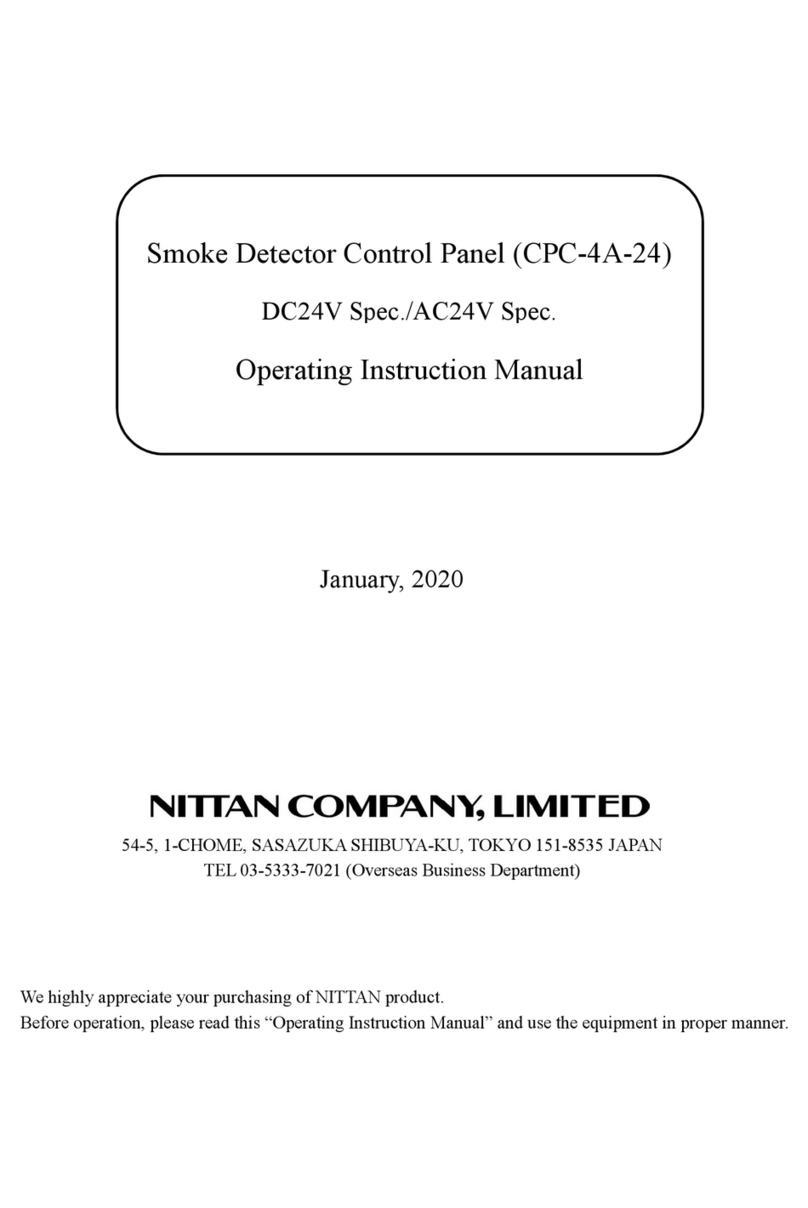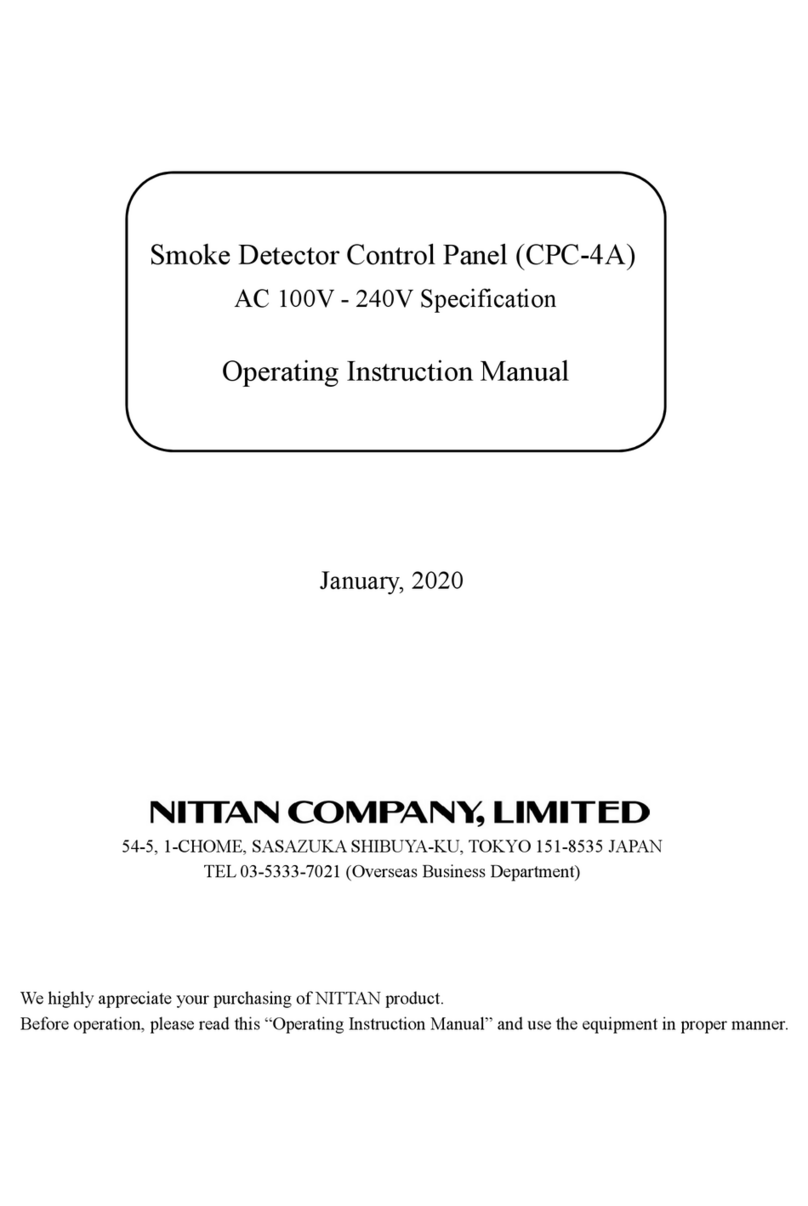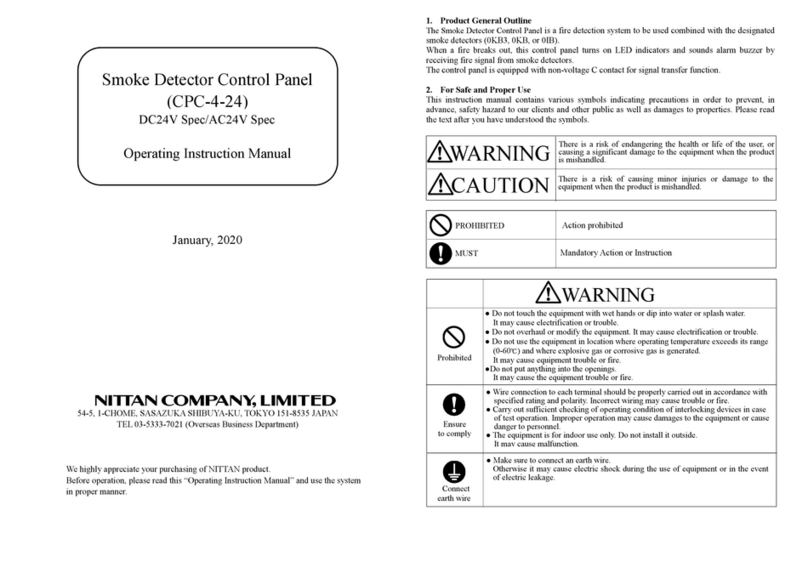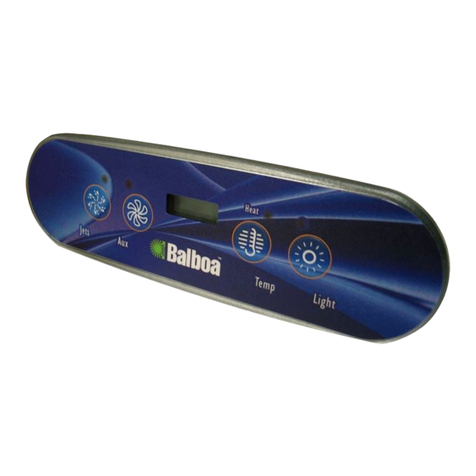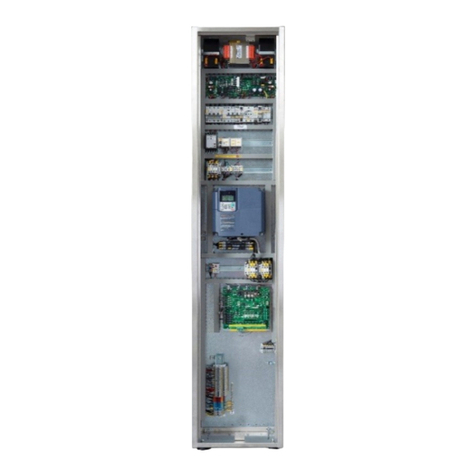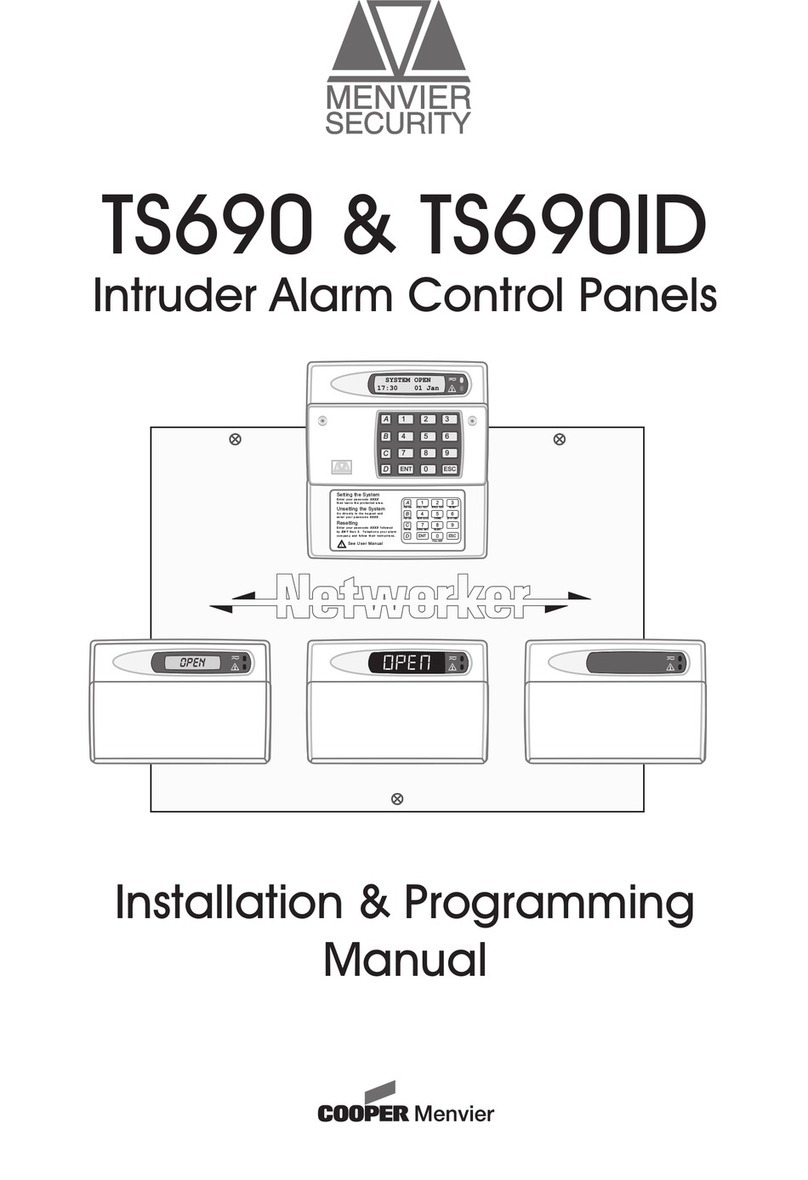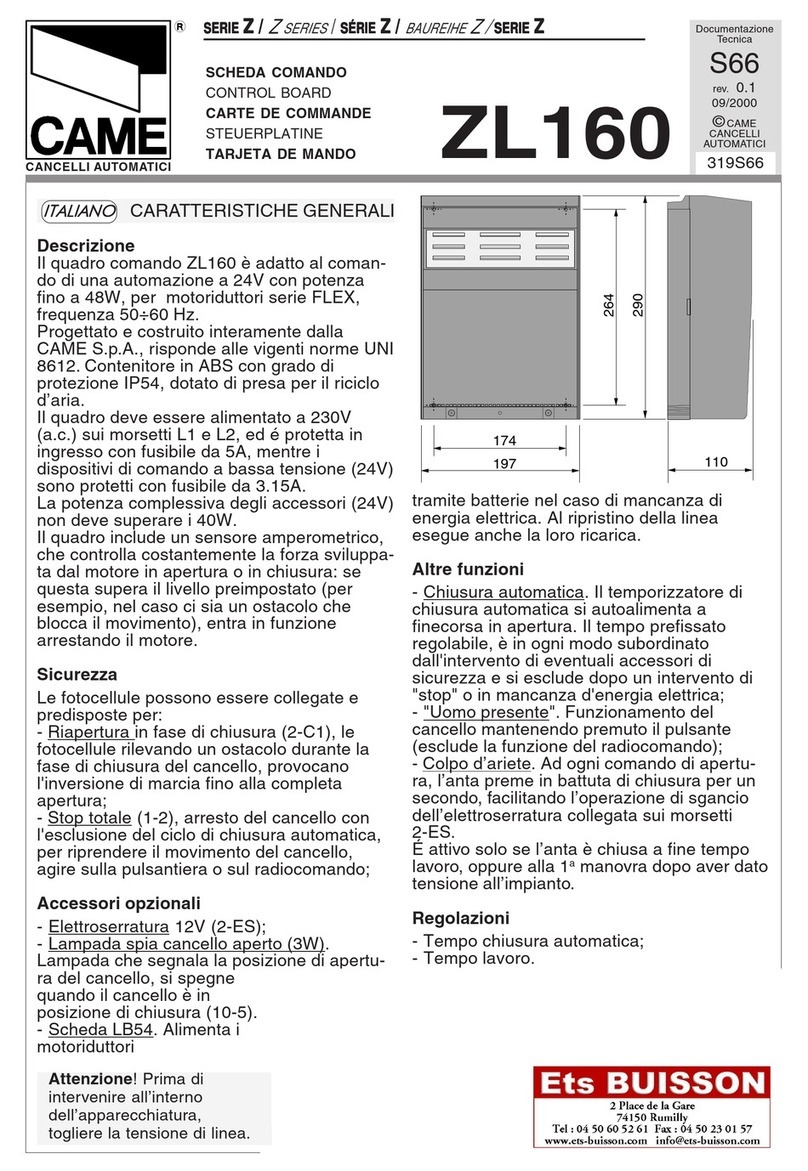Nittan 1PM3-nLA Instruction Manual

AUTOMATIC FIRE ALARM SYSTEM
Conventional Fire Alarm
Control Panel
Operating Instruction Manual
Thank you for accepting Nittan Fire Alarm System
●Equipped with alarm delay function.
Maintains nominal 60 seconds delay time to reduce unwanted
alarm caused by transient smoke and heat.
●Equipped with individual alarm delay OFF function.
Specific zone alarm delay function can be cancelled by
switch operation at random and can be available at site
operation.
●Equipped with trouble monitoring function.
Detector wiring, wiring to emergency PA, zone bell fuse line
fault constant monitoring, lowering of circuit voltage
(below 20.4 V), charging circuit (standby battery) and
self monitoring of CPU trouble.
●Re-sounding mode of panel alarm sounder. .
After alarm silence, automatically re-sounds by operation
of manual alarm station or by receipt of alarm signal
from other zone.
●Highly reliable design.
LED is used for all indicators. Solid state by avoiding relays to the utmost and high function,
high reliability in design by adopting CPU.
●Extra thin design (wall mounting type).
Thickness of wall mounting type is 100 mm.
●Signal transfer of detector reset pulse can be possible.
●Enhanced thunder-proof measures.
Enhanced thunder-proof measures have been applied to input line from detector etc.
●At emergency PA, zone alarm bell silence circuit is standard equipment.
●3 zones of alarm indicator circuit is standard equipment
Even when CPU is down, fire signal can be received and alarm is indicated. But alarm delay
circuit and self-holding circuit do not function.
●The second fire signal transfer is standard equipment. Emergency PA transfer is also equipped.
●By adopting plug-in terminal, one touch wire connection of external terminals is possible,
Feature
1PM3-nLA Type

1. Caution on Safety ················································································1
2. Name and Function of Each Section ························································2
3. Condition of Monitoring Time and Fire Alarm Time ···································7
4. Various Testing Methods ·······································································9
5. Symptom of Fuse Meltdown································································· 10
6. Block Diagram ·················································································· 11
7. Connection Examples of Various Signal Transfer ····································· 12
8. Standard Specifications ······································································ 14
9. Inspection and Maintenance ································································ 16
Table of Contents

1
Before using this control panel, please carefully read this Operating Instruction Manual and use
the panel correctly. Also keep this manual safely.
In order to indicate a degree of impending danger or damage, conditions expected to occur, if improperly operated,
are indicated by WARNING and by CAUTION.
WARNING
This indicates a possibility that yourself or other people may be killed or be seriously injured
by improper operation.
CAUTION
This indicates a possibility that yourself or other people may be injured and equipment and
property may be damaged by improper operation.
Caution on Safety
WARNING
◎Qualification of Fire Protection Engineer is required to install this control panel.
Please ask us or engineering works company, without fail, to install. Please conduct installation of this control
panel in accordance with Installation Manual.
◎Do not open control panel except by authorized personnel (Fire Protection Engineer etc), otherwise equipment
function may be lost and injury may be caused by electrification.
◎When this control panel is at monitoring mode, please set all switches at normal positions.
◎Please do not modify the control panel or replace its parts, otherwise equipment function may be lost and injury
may be caused by fire or electrification.
◎When gas detector actuates, shut-off main cock and inform gas company. Never put any objects which may cause
fire and static electricity, closer to the control panel.
They may cause fire.
Caution on Safety at Maintenance and Inspection Time
CAUTION
◎Please avoid installation of this equipment where ambient temperature exceeds 40℃and below 0℃, otherwise
this may cause fire and electrification and also equipment function may be lost.
◎When any trouble condition is found, please contact and consult with us, engineering works company or
maintenance contract company, otherwise this may cause fire and electrification and also equipment function
may be lost.
◎Please secure effective space to enable switch operation in case of emergency, otherwise this may cause fire and
electrification and also equipment function may be lost.
◎Switch operation shall be carried out in accordance with the attached Operating Instruction Manual and
explanation label attached to the equipment, otherwise this may cause fire and electrification and also equipment
function may be lost.
WARNING
◎When you change standby battery, please connect plus to plus and minus to minus securely and avoid causing
short-circuit between electrodes. Short-circuit between electrodes causes liquid leakage, heat generation, injury or
damage by burst.
CAUTION
◎Do not install equipment where a lot of vibration, noise, humidity, dust exist and corrosive gas can be generated,
otherwise this may cause fire and electrification and also equipment function may be lost.
◎In case effects of thunderstorm, earthquake and flood damage are worried, equipment maintenance and
inspection shall be carried out in consultation with maintenance contract company, in addition to statutory
regular inspection.
Otherwise this may cause fire and electrification and also equipment function may be lost.
◎When you exchange a detector, tightly fix to the socket by turning the detector until it clicks. If not, a detector
may not function properly.
◎Life of standby battery (Nickel Cadmium battery) is about 5 years. Please replace as appropriate by checking its
period in use, otherwise, it may not function properly.
◎When you clean equipment, please be careful not to touch switches by mistake.
Also confirm that the equipment is at normal monitoring condition all the time, otherwise this may cause fire and
electrification and also equipment function may be lost.
◎When you exchange a fuse, first shut-off power supply, then replace with specified current capacity fuse. If you
use a fuse other than specified capacity, it may catch fire and cause trouble.
◎Insulation resistance test shall be conducted only after applying necessary procedures for high voltage fracture
prevention, otherwise it may cause trouble.
1. Caution on Safety

2
1
9
2
3
4
7
6
8
5
10
2. Name and Function of Each Section
Control Panel External View
①
Cabinet
②Door
③Zone Alarm Indicator
④Zone Name
⑤Operating Panel
⑥Operating Panel Cover
⑦Lock
⑧Simple Operation Manual Nameplate
⑨Hanger
⑩CUD label
Zone Alarm Indicator
When a fire breaks out, it indicates
fire starting place.
Also when line break occurs at
detector line, it indicates line break
zone by flickering.
Difference in Zone Indicator Light
at fire time
at line break time
turning on
flickering
Detector or manual alarm
station operates and fire
condition is indicated.
Detector line is broken and
is in abnormal condition.

3
This control panel has alarm delay function of max. 60 seconds for the fire signal from detector.
Summary of delay operation is as follows. (The time is from all fire signal input time.)
About 10 seconds after detector operates, a reset pulse is output and detector is forced to reset
automatically. About 20 seconds later, the control panel becomes fire signal count mode and when
detector operates again, the control panel outputs fire alarm. Fire signal count mode continues for
about 60 seconds and the panel returns to monitoring condition unless a detector actuates by then.
There are two ways of delay time and fire alarm is output about 20 seconds after heat detector
operates and about 20~60 seconds after smoke detector operates.
When manual alarm station operates, fire alarm is output immediately.
(1) Fire indicator·····················Turns on (red), when a fire breaks out.
(2) AC power indicator ·············Normally turning on (blue) and indicates AC power is
being supplied to control panel. If AC power indicator is turning
off, this means either power failure or fuse (F1・F2・F4)
meltdown.
(3) Circuit voltage indicator ······Indicates power-on condition of control panel circuit voltage.
When circuit voltage becomes lower than about 20.4V, the light
turns off.
(4) Switch operation indicator ···If any one of switches is not at normal position, the light (red)
flickers. (Operation of dip switch in the control panel does not
make the light flicker.)
(5) Telephone indicator·············When a handset plug is inserted to a telephone jack of manual
alarm station or annunciator panel, the telephone light turns on
(red).
(6) Maintenance indicator·········When maintenance switch in the control panel is pressed to
maintenance side, the light flickers (red).
(7) Zone alarm bell silence indicator --
(a) when zone alarm bell silence switch is pressed at fire, zone
alarm bells silences.
(b) when maintenance switch is pressed to maintenance side, the
light flickers.
(8) Alarm delay indicator··········When fire signal is received, when at fire test or when to
measure delay time, this alarm delay indicator turns on (red).
The light turns off about 60 seconds later when no fire alarm is
output.
When general alarm delay switch (S29) in the control panel is
pressed to OFF side, alarm delay indicator flickers.
(The light does not flicker by operation of individual alarm delay
OFF switch.)
2. Name and Function of Each Section
Operating panel detailed explanation
1
2
3
4
5
17
18
19
20 22 23 24 25
21 26 27 28 29
6 16
8
9 10 1211
13
14
15
7

4
(9) CPU trouble indicator ·········When CPU, handling with signals of alarm delay circuit and fire
circuit etc, becomes in trouble, this indicator turns on. When this
indicator turns on, immediately contact maintenance contract
company because urgent repair is necessary.
(10) Fuse fault indicator···········When zone alarm bell output fuse (F6) melts down, the light
turns on (red). When the fuse is exchanged, the light turns off.
(11) Battery fault indicator ·······When standby battery is not connected, the light
turns on (red).
(12) Emergency PA indicator·····At emergency PA and when zone alarm bell silences, the light
flickers. At signal line fault, the light turns on.
(13) Manual alarm station ············ When fire signal is received from manual alarm
indicator station, the light turns on (red).
(14) Hydrant operation ············When hydrant pump actuates, the light flickers(red).
indicator
(15) Other Alarm indicator ·······When alarm signals of fire extinguishing system etc are
input, the light turns on (red).
(16) Panel buzzer ····················
1. Main alarm
The panel buzzer sounds continuously to inform a fire. Even buzzer is
silenced, it will re-sound by operation of manual alarm station or when
other zone line becomes fire condition.
2. Alert tone
This will intermittent sound at telephone calling time, at battery fault, at
fuse fault, at turning on of other alarm and emergency PA,
at sounding of line fault and circuit voltage fault (below 20.4V).
3. Maintenance tone
When the maintenance switch is operated, the panel buzzer sounds with a
small click sound once in 10 seconds. After that, if pressing and holding the
Panel Alarm Silence Switch, the panel buzzer is changed to sound once in
60 minutes. When this change is performed, the blinking cycle of Zone
Alarm Bell Silence Indicator will change.
If pressing and holding the Panel Alarm Silence Switch again, or operating
the Maintenance Switch again to be back to the initial position, then the
panel buzzer is also back to the original sound, once in 10 seconds.
4. CPU trouble tone
Main CPU is in trouble, the panel buzzer sounds continuously with small
sound volume
(17) Telephone jack··················Insert a handset plug into this jack while control panel buzzer
is sounding and telephone light is turning on, then buzzer
silences and telephone communication becomes possible. After
telephone communication, unplug handset and confirm
telephone indicator light turns off.
(18) Panel alarm silence switch······When this switch (red) is pressed to silence side, fire alarm
(16-1) silences. The sounder resounds when the panel receives
fire signal from other zone so that press the switch again to
silence side to stop sound. The switch is bounce-back type and
returns to normal position after operation. Also when this switch
is pressed to silence side, alarm buzzer (16-2) also stops.
Note: Telephone calling alarm buzzer sound can not be silenced
by this switch.
(19) Zone alarm silence switch·······When pressed at zone alarm bell sounding time, zone alarm
bells silence.
2. Name and Function of Each Section

5
The following switches are located inside of the operating board front cover.
(20) Reset switch·····················When this switch (red) is pressed to reset side, fire indicator etc
(turning on of zone alarm indicator, alarm delay indicator,
sounding of panel alarm sounder and zone alarm bell) are reset.
These switches are bounce-back type so that when you release
the switches after operation, they return to their normal
positions.
Please note that CPU needs rise time of 2~3 seconds after
operation.
(21) Alarm transfer····················When this switch is pressed to stop side, fire signal transfer to
isolation switch ·security company etc is shut-off. At this moment, switch
operation light (4) starts to flicker.
(22) General alarm switch ········When this switch is pressed to sound side, all of zone alarm
bells can be sounded even not at fire. Also, this switch
supersedes all other silence switches. At this moment, switch
operation indicator (4) starts to flicker.
If emergency PA signal transfer circuit is available, signal
transfer is output to all areas by this switch operation.
Note: Depending upon a type of system, bells may not be
installed so that careful attention must be paid to its handling.
(23) Hydrant isolation switch---- Fire pump interlocking by operation of manual alarm station is
cancelled. At isolation time, switch operation light (4) starts to
flicker.
(24) Emergency PA ·················When this switch is pressed to silence side, signal transfer to
isolation switch emergency PA silences. At this moment, switch operation light
(4)starts to flicker.
(25) Fire test switch·················This switch is used to measure alarm delay time at fire test.
When the switch is pressed to test side, switch operation light
(4) starts to flicker. Also, when switch is returned to normal
position after pressing to test side for 1~2 seconds, alarm delay
confirmation light turns on. For details, please refer to fire test
items. Do not conduct battery test at the same time with fire
test.
(26) Zone selection tens digit·····After pressing fire test switch (25) to test side, configure
tens digit by this switch.
(27) Zone selection ones digit----Press fire test switch (25) to test side and first configure tens
digit by circuit selection switch (26), then ones digit by this
switch and carry out the test.
(28) Auto Reset switch ·············When operation test of detector and manual alarm station is
conducted, press this switch to reset side, then switch operation
light (4) starts to flicker and fire holding function and alarm
delay function are cancelled.
(The control panel can be automatically reset, either by detector
reset pulse which is output every few seconds or by manual reset
operation of manual alarm station.) From then onward, fire test
is conducted per every one zone operation.
(29) Battery test switch············This switch is used for standby battery test. When the switch
is pressed to test side for about 1 minute and if Circuit Voltage
indicator (3)turns off, it is necessary to inspect charge circuit
and standby battery. The switch is bounce-back type so that
when you release the switch, it returns to normal position.
2. Name and Function of Each Section

6
The following switches and indicators are located inside the control panel.
Main power supply··················This switch functions ON and OFF of AC power supply (AC 220V)
switch (S1) constantly used by fire alarm control panel. When pressed to On side,
AC Power indicator (2) turns on and power is supplied.
Alarm delay ON/OFF ·············When this switch is pressed to OFF side, fire signal delay by detector
input is cancelled and fire is indicated immediately. At this moment,
alarm delay indicator and switch operation indicator (4) start to
flicker.
Individual alarm delay ···········This switch is used when you wish to use a specific zone as alarm
ON/OFF switch (S101) non-delay type. By configuring switch S101, located inside zone pcb, to
OFF, it becomes non-delay type. Please handle carefully because
switch operation light does not flicker by these switches.
Zone selection switch (S8C) ······One fire alarm zone pcb covers 10 zones and its switch
has 6 pole contacts and is configured by every 10 zone by installation
of zone board.
Example: S8C for zone corresponding to 1~10 of zone selection tens
digit switch of operating board is ON only for the 1st switch.
These switches are already configured upon factory shipment.
Also these switches (alarm delay OFF switch, individual alarm delay
OFF switch S101, zone selection switch S8C) are used by Fire
Protection Engineer etc when system is configured, therefore, please
do not operate these switches after installation of the control panel.
Maintenance switch·················This switch is used to silence all alarms when you do not wish to
(all alarm silence) sound alarm device at maintenance/inspection time. By this switch
operation (excluding telephone calling buzzer),
maintenance indicator (6), zone alarm silence indicator (7), and switch
operation indicator (4) start to flick and maintenance sound.
Even under this condition, when general alarm switch is operated,
zone alarm bell starts to sound in all area.
Note: It is very dangerous to use this switch at normal time. Please
make sure to use this switch at normal position.
CPU reset switch ····················When this switch is pressed, CPU resets once and when you release
your finger, it returns to normal condition.
CPU RUN light·······················This indicator (green) turns on when CPU functions properly.
Function of Each Section
2. Name and Function of Each Section

7
When detector operates by heat, smoke or flame, zone alarm indicator turns on
Alarm delay confirmation light turns on.
After passing delay time (20~60 seconds), fire indicator turns on.
Panel alarm sounder and zone alarm bell start to sound.
When manual alarm station is pressed, zone alarm indicator turns on.
Manual alarm station indicator turns on.
Alarm delay confirmation light turns on.
There is no alarm delay time function on manual alarm station, so fire indicator turns on
immediately.
Panel alarm sounder and zone alarm bell start to sound.
3. Condition of Monitoring Time and Fire Alarm Time
The following is monitoring condition at normal time.
All zone indicators are
turned off. If flickering,
the zone detector wiring is
at fault, so immediately
contact inspection
com pan y.
“AC Power Supply” light
(blue) is turning on all
the time.
“Circuit Voltage” light
(blue) is turning on.
“Switch Operation” light
(red) is turning off.
When flickering, switch
is not at normal position.
Set all switches at
normal position.
Fire Alarm Time
When detector alarms
When manual alarm station alarms

8
1. Identify fire zone by zone alarm indicator.
2. Rush to the site and upon confirming the fire condition, take appropriate course of action such
as initial fire fighting, report, evacuation and guidance etc.
1. First silence panel alarm sounder and zone alarm bell.
2. Then confirm the following at the zone, for which zone alarm indicator is turning on.
a) whether manual alarm station is pressed or not.
If pressed, pull back the push button and reset.
b) whether detector is operated or not.
Detector equipped with confirmation light is turning on its confirmation light.
In this case, check environmental condition of detector surroundings.
This will help clarify causes of unwanted alarms and formulate its prevention measures.
3. Open front switch cover and press “Reset” switch to reset side and confirm that zone alarm
indicator turns off.
When fire alarm sounds, please carry out the following procedures, without panic.
If alarm is not for fire (unwanted alarm, false alarm), please carry out the following procedures.
If the system does not return to normal monitoring condition after the above operation, urgently
contact inspection company.
3. Condition of Monitoring Time and Fire Alarm Time

9
Before test, press “Alarm Transfer Isolation” switch, “Hydrant Isolation” switch and if necessary,
“Maintenance” switch to maintenance side.
A. When every 5 zones are tested. (normally test is carried out in this manner).
①Press “Fire Test” switch to test side.
②Set “Zone Selection Tens Digit” switch to “1~10” and set “Zone Selection Ones Digit” switch
to ”1”, then the 1st “Zone” alarm indicator turns on and at the same time, “Alarm Delay”
indicator turns on.
After passing specified alarm delay time (20 seconds), the common “Fire” indicator turns on
and panel alarm sounder and zone alarm bell start to sound.
When “Panel Alarm Silence” switch is pressed downward, panel alarm sounder silences and
“Zone Alarm Silence” switch is pressed downward, zone alarm bell is silenced but when
“Maintenance” switch is pressed to maintenance side, all zone alarm bells do not sound.
However, “Alarm Delay” light continues to turn on.
③When “Zone Selection Ones Digit” switch is set to “2”, the 2nd “Zone” alarm indicator turns
on and panel alarm sounder starts to re-sound. At this moment, the 1st “Zone” alarm
indicator remains turning on. The rest of remaining zones can be set to alarm condition one
by one, but after the 1st zone alarm, fire test for the 2nd zone onward is carried out under
alarm delay cancelled condition.
④After completion of the 5th zone test, press “Reset” switch downward to conduct reset
operation, then set “Zone Selection Ones Digit” switch to “6” and carry out the test for the
6th zone to the 10th zone in the same manner.
⑤When the 11th zone test is carried out, set “Zone Selection Tens Digit” switch to “11~20” and
set “Zone Selection Ones Digit” switch to “1”.
Note: Do not test over 5 zones at the same time since this may cause some trouble.
B. When every one zone is tested.
Press downward “Fire Test” switch and “Reset” switch and configure “Zone Selection Tens
Digit” switch to “1~10”. When you operate “Zone Selection Ones Digit” switch from 1, fire
test can be carried out per zone. When “Auto Reset” switch is pressed to “RESET” side,
alarm delay function is cancelled but “Alarm Delay Confirmation” light turns on.
C. When a specific selected zone is tested.
Configure the specified zone by “Zone Selection Tens Digit” switch and “Zone Selection Ones
Digit” switch and press “Fire Test” switch downward. “Zone” alarm indicator and “Alarm
Delay” indicator turn on and after pre-determined delay time (20 seconds), “Fire” indicator
turns on and alarm sounder sounds.
Note: When reset operation is made by “Reset” switch, CPU is cleared once.
CPU needs rise time of 2~3 seconds.
Please confirm “Circuit Voltage” indicator is turning on when “Battery Test” switch is pressed
downward. When the light is turning on, standby battery to be used at power cut is in normal
condition. When “Circuit Voltage” light turns off (at below 20.4V) and alarm buzzer sounds,
inspect charge circuit and battery. Please pay attention that alarm buzzer can not sound if
standby battery is nearly flat. Also, at battery test when AC power is supplied, “AC Power
Supply” light remains turning on.
4. Various Testing Methods
Fire Test
Standby Battery Test

10
The following two types of time are measured.
A. Nominal delay time (smoke detector delay time).
B. Fire alarm delay time (heat detector delay time).
B-1 Measurement of nominal delay time.
(1) Press downward “Fire Test” switch for 1~2 seconds and as soon as the switch is
returned to normal position, start measuring the time by stop watch etc. At this moment,
“Alarm Delay” indicator turns on.
(2) “Alarm Delay” indicator turns off after passing a certain period of time. As soon as the
indicator turns off, stop measuring the time.
(3) Record this elapsed time as “Nominal Alarm Delay Time” and if it remains between
55~60 seconds, it is normal.
B-2 Measurement of fire alarm delay time.
(1) Configure “Zone Selection Tens Digit” switch to “1~10” and “Zone Selection Ones
Digit” to “1”. Next, as soon as “Fire Test” switch is pressed downward, start measuring
the time by stop watch etc. At this moment, the 1st “Zone” alarm indicator light and
“Alarm Delay” indicator turn on.
(2) “Fire” indicator turns on after passing a certain period of time. As soon as the indicator
turns off, stop measuring the time.
(3) Record this elapsed time as “Fire Alarm Receipt Start Time” and if it remains between
15~20 seconds, it is normal.
Note: Please measure the time 2~3 seconds after “Reset” switch operation. When you
measure alarm delay time, set “Alarm Transfer Isolation” switch to silence side
and “Hydrant Isolation” switch to isolation side and “Maintenance” switch to
maintenance side, then carry out the measurement.
Fuse
Sym
bol
Fuse
Capacity (A)
Fuse For
Symptom of Fuse Meltdown
5LA,
10LA
15LA~
40LA
F1
F2 1A 1A Power supply
primary side
“ AC Power” indicator turns off, the same condition as
power cut and changeovers to standby battery. Only
“Normal” indicator continues to turn on.
F3 1A 1A Indicator Indicator lights installed at corridor etc turn off.
F4 2A 3A
Power supply
secondary side
“ AC Power” indicator turns off.
F5 2A 3A
Standby battery
circuit
“Circuit Voltage” light turns off at power cut and at
battery test time.
F6 1A 1A Zone alarm bell Zone bell does not sound. Alarm buzzer sounds.
F7 0.5A 0.5A Manual alarm
station
Push button switch of manual alarm station is pressed
and response light of the manual alarm station does not
turn on even when fire signal is transferred.
F8 0.5A 0.5A Annunciator Each indicator light of annunciator and alarm device do
not sound.
Measuring Delay Time
5. Symptom of Fuse Meltdown
4. Various Testing Methods

11
6. Block Diagram

12
Annunciator connection
Signal transfer terminal connection
GB
rfa
GC
Signal device
voi ce・flickering guide light
GA
GB
rfa
GC GA
Fire information
receiving device
Fire information
receiving device
GB
rfa
GC GA
J
S
IC ~
I+ I1 In
IB
C
T
BZ
IC ~
I+ I1 In
IB
C
T
annunciator
control panel
side
(1) signal transfer to security company etc.
1-1 in case of constant open route type
1-2 in case of constant close route type
(2) signal transfer to guide light signal
device
(1) signal transfer to security company etc.
7. Connection Examples of Various Signal Transfer

13
Zone bell connection example
Connection examples of signal transfer to Emergency PA system.
EB EB'EC
S24
rf rf2rbx1rbx2rbx15
EF1
EF
EF2EA1EA2EA15
EB EB'EC EL2EL1EL15
RBB
RBX15 RBX4RBX3RBX2RBX1
RBA
CPU
Common board
Control Panel
4
rb
15CN21-5
rba F6
B15
B
BF
1F
2F
nF
3F B
B
B
B
B3
B1
BC
B2
rbx15
rbx1
rbb
rbx2
rbx3
Q8
S9 rba
2
1
PC-03157
B4
B15
CN14-1
CN14-2
CN14-3
CN14-4
CN14-5
CN15-1
CN15-2
7. Connection Examples of Various Signal Transfer
※
Please bundle up all connector leads by
type and connect to terminals.
EF
1
----fire confirmation (common fire and manual alarm station fire)
EF2----fire confirmation (2nd fire signal transfer and manual alarm station fire signal transfer)
※EA terminal number becomes the same as zone number, in case of less than 10 zones.

14
Item
Specification
Power supply
Main power supply: AC 220 (50~60Hz), variation 198~242V.
Standby battery: built-in sealed type Nickel Cadmium battery.
Number of detector fixed
Smoke, spot type detector (2KH etc): Max.40 per zone, in total
less than 20 x zone number.
Heat type detector: as required.
External wire resistance
Below max. 50 ohm.
Fire test
By fire test switch method or by zone selection switch (rotary type) test method.
Detector line fault monitor
Line fault constant monitoring method using special end-of-line device (CRE). At line
fault, zone light flickers and alarm buzzer sounds.
Fire indicator
Red LED 2 lights----turn on at fire time.
Zone alarm indicator
Red LED 1 light----flickers at fire time and line fault time.
AC power indicator
Blue LED----turns on when AC power is supplied.
Switch operation indicator
Red LED----flickers at lock switch operation condition.
Circuit voltage indicator
Blue LED----turns on at normal circuit voltage. The light turns off at lowering circuit
voltage (below about 20.4V). Warning buzzer sounds.
CPU RUN indicator
Green LED----turns on at CPU normal function time and turns off at CPU trouble time.
(PC-03156 and PC-03158 backside)
CPU trouble indicator
Red LED----turns on at CPU trouble time and CPU trouble sound (small sound volume:
main).
Battery fault indicator
Red LED----turns on when standby battery is not connected.Alarm buzzer sounds.
Fuse fault indicator
Red LED----turns on when zone alarm fuse is at line fault.Alarm buzzer sounds.
Manual alarm station
indicator
Red LED----turns on when fire signal from manual alarm station is received.
Telephone indicator
Red LED----turns on when telephone call from manual alarm station or annunciator is
received.
Alarm delay indicator
Red LED----turns on at alarm delay circuit function time.
Flickers when alarm delay cancel switch (S29) is ON (The light does not turn
on at individual alarm delay cancellation time.)
Other alarm indicator
Red LED x 3----turn on when external alarm is received.
Alarm buzzer sounds.
Emergency PA indicator
Red LED----flickers when emergency PA signal is received and turns on when signal line
is at fault.
Alarm buzzer sounds.
Maintenance indicator
Flickers at maintenance switch operation time (red).
Zone alarm bell silence
indicator
Flickers at zone alarm bell silence time and at maintenance switch operation time (red).
Panel inside switches
Main power supply switch, alarm delay cancel switch, individual alarm delay cancel
switch, maintenance switch, CPU reset switch, zone configuration switch.
Operating panel switches
Outside of operating cover: Alarm silence (Non-lock),
Zone alarm bell silence.
Inside of operating cover: fire reset (Non-lock), signal transferisolation, general alarm,
hydrant isolation, fire test, zone selection (rotary), test reset, battery test
(Non-lock),emergency PA zone alarm transfer isolation.
Panel alarm sounder
Piezoelectric buzzer-resounding type.
Common alarm device
Telephone calling time, zone alarm bell fuse line fault time, standby battery omission
time, emergency PA line (EB, EB’) fault time, external alarm signal receiving time.
External signal transfer
Contact capacity DC24V
Fire common signal transfer F-F’(a contact) 1A
Fire signal transfer GA-GB-GC(C contact) 1A
Detector reset pulse signal transfer N-N’(b contact) 0.5A
External alarm signal transfer(1L only) XA-XC(a contact) 1A
Emergency PA signal transfer(EC, EF, EF2, EA1~EA15) 1A
EC(a contact
Common----EA1~EA15 is standard equipment over 15 lines.
Less than 10 lines-----the same number as zone number.
Annunciator: special annunciator 1 set can be connected.
Auxiliary function
Power supply for indicator light AC25V 0.4A
Zone number
5~40L----wall mounting type
Telephone
1 line, telephone jack type
8. Standard Specification

15
Zone Alarm Device, Rating, External Size
●Wall mounting type
Zone No. L 5 10 15 20 25 30 40
Zone bell connection quantity 10 20 30
Zone bell block quantity 5 10 15
Rated primary current (AC220V) 0.39A
Indicator light power supply
capacity(AC25V)0.4A
Standby battery capacity (Ah) 0.45
External dimension
Height x Width x Depth (mm) 760 x 450 x 100 1060 x 450 x 100
Note: Zone bell connection quantity: A quantity when motor bell DC24V, 10mA is connected.
P type, Class 1 Control Panel Accessory List
(1PM3-nLA)
Item Name Quantity
5~10LA 15~40LA
Fuse 0.5A 2 2
Fuse 1A 4 4
Fuse 2A 2 0
Fuse 3A 0 2
Without fuse 1
Hexagonal wrench 1
Zone plate sheet 5
Zone window transparent plate 3
Alarm indication zone name sheet (orange) 1
Alarm indication transparent plate 1
These accessories are for the use of fire alarm control panel.
Do not use for other purposes.
8. Standard Specification

16
Inspection and maintenance of fire protection system etc and report of its result to Fire Service
Authority are required under Japan Fire Service Law, therefore, we recommend you to carry out a
similar inspection and maintenance at your end.
Type of fire protection
system Inspection content and method
Inspection
period
Automatic fire alarm
system
Inspection of external view and function
6 months
Overall inspection
12 months
Wiring
Overall inspection
12 months
These regular inspections and report to Fire Service Authority shall be carried out by qualified
personnel such as fire protection engineer, upon signing maintenance inspection contract with
installation company etc.
Installation: year month date
Installation
Name of Installer
Address
Tel.
Maintenance
Contract
Name of Maintenance Co.
Address
Tel.
9
. Inspection and Maintenance
When any trouble is found on the equipment, please contact to the following address.
Point of Contact
Telephone No.: ( ) --
Fax No.: ( ) --


54-5, 1-CHOME, SASAZUKA, SHIBUYA-KU, TOKYO, 151-8535, JAPAN
TEL: +81-3-5333-7021
URL: http://www.nittan.com/english
20.03B
Table of contents
Other Nittan Control Panel manuals
Popular Control Panel manuals by other brands
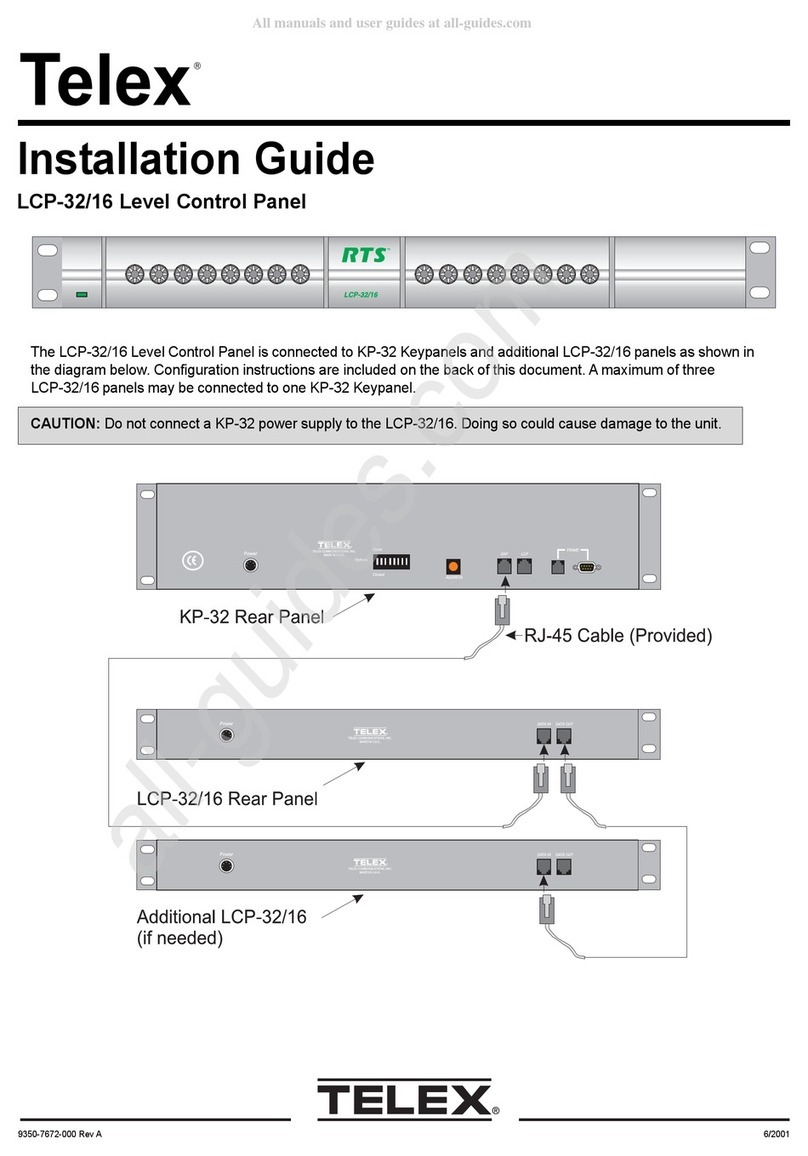
Telex
Telex LCP-32/16 installation guide
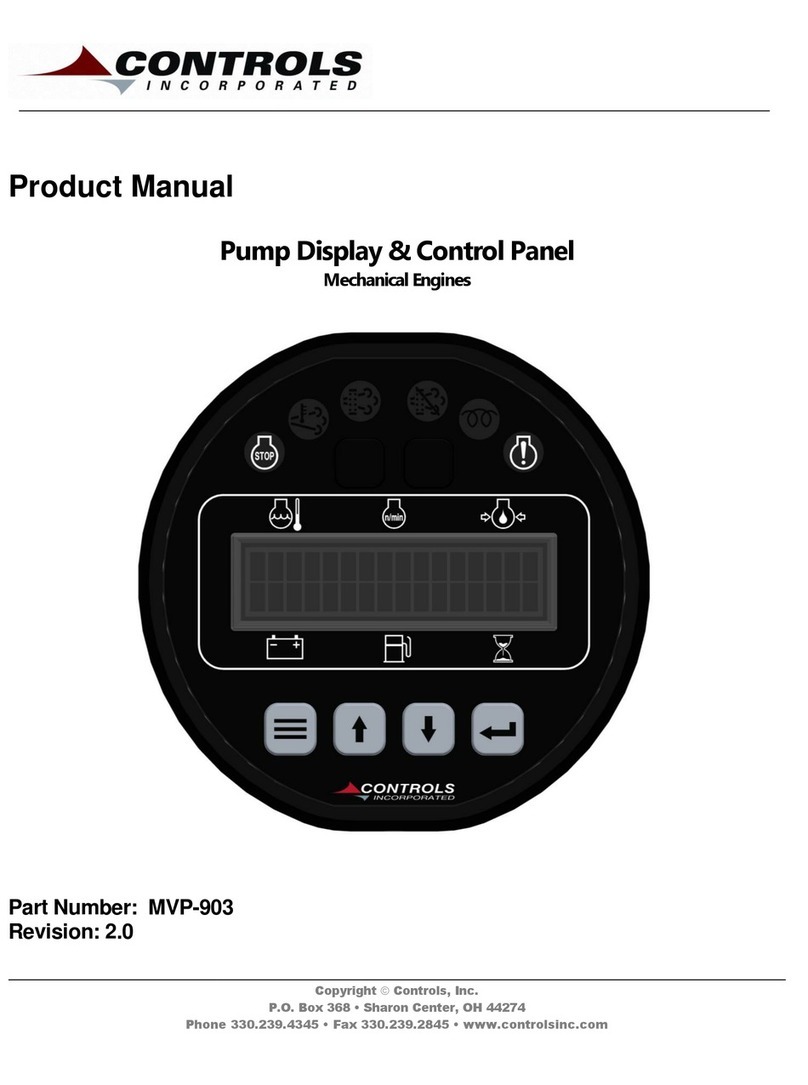
Controls
Controls MVP-903 product manual
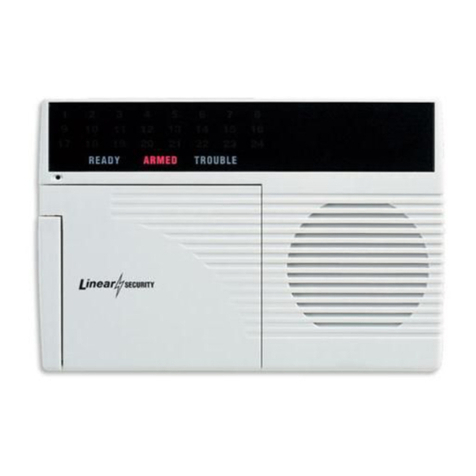
Linear
Linear Security DUAL 824 Installation & programming instructions
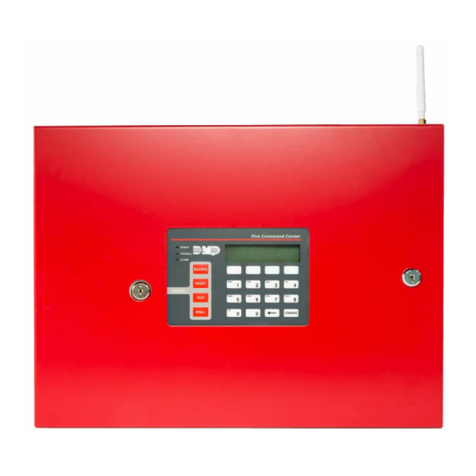
Digital Monitoring Products
Digital Monitoring Products XR150FC installation guide

Visonic
Visonic POWERART installation instructions

U-Prox
U-Prox MP user manual
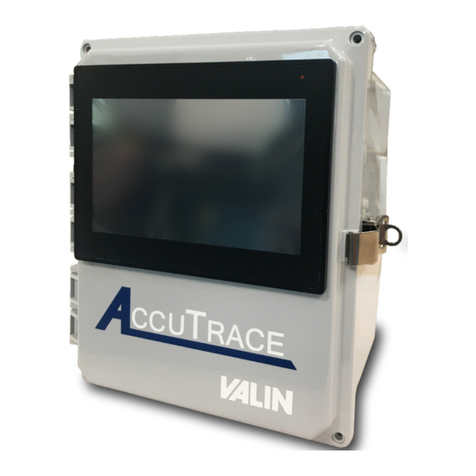
Valin
Valin AccuTrace manual

Tangent Wave
Tangent Wave Ripple user manual
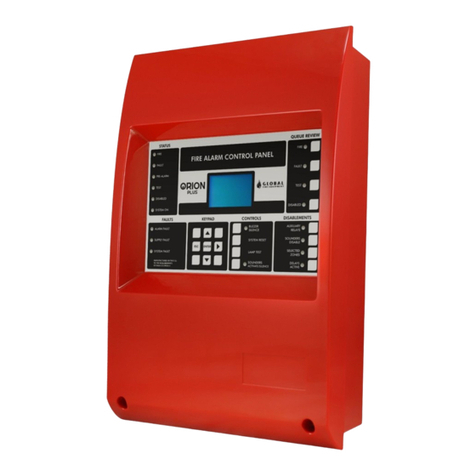
Global Fire Equipment
Global Fire Equipment ORION PLUS Operation manual

Ferroli
Ferroli 0Q2K10XA Installation and assembly instructions

Riello
Riello RIELLOtech PRIME Installation, operation and maintenance manual
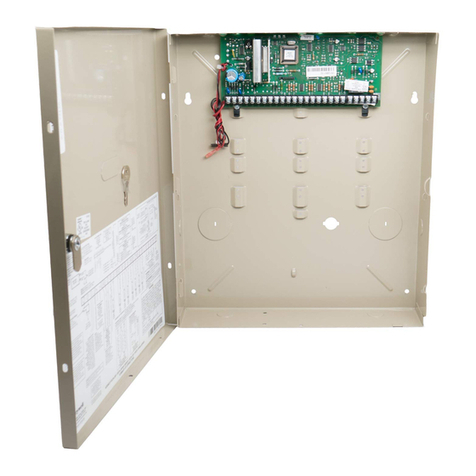
ADEMCO
ADEMCO VISTA manual
